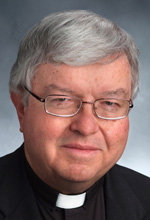Q. I believe in the evolutionary theory of creation and have never given much thought to its impact on Christianity — until recently. While talking to a local priest, he mentioned that Adam and Eve were fictional characters who have provided generations with lessons on good and evil and who also provided the foundation for redemption.
I agreed, but later it made me wonder about all that follows in the Bible: the concept of original sin, the promise of a savior, etc. And so, simply asked, my question is this: Without the fall of Eve in Eden, where, when and why does the promise of a savior originate? (Virginia Beach, Virginia)
A. The virtually universal view of contemporary Catholic biblical scholars is that the Genesis account of creation is not a textbook of history and scientific fact, but is meant to convey religious truths.
The theory of evolution is widely accepted by natural scientists, and in a message delivered in 1996 to the Pontifical Academy of Sciences, St. John Paul II said that evolution should be viewed as “more than an hypothesis.”
[hotblock]
In that same allocution, St. John Paul went on to say that theories of physical evolution of the human species do not contradict Catholic teaching so long as they allow for the spiritual dimension of the human person.
In other words, one is free to believe that while the human species evolved physically over millions of years, that entire process was presided over and guided by God, and God directly created the human soul.
As for original sin, I certainly would not call Adam and Eve “fictional characters.” Many scholars do theorize, though, that they were most likely not two specific individuals but represented instead an entire early generation of men and women.
As the Second Vatican Council says in No. 13 of “Gaudium et Spes”: “Although he was made by God in a state of holiness, from the very onset of his history man abused his liberty at the urging of the Evil One.”
In their view of original sin, the Greek Fathers of the Church held that the sinfulness of our earliest ancestors is carried forward by the choices of every generation — so that each of us arrives in the world, if not with a genetic predisposition to sin, then at least surrounded by a society in which selfishness seems to abound.
Thus, we have a need for the redeemer promised throughout the Old Testament: to balance out that early failure, to open the path to heaven and to enable us to overcome self-interest and to direct our lives outward.
Q. Is the exchange of rings necessary in a Catholic wedding ceremony? My daughter doesn’t wear any jewelry and doesn’t intend to wear a wedding ring either. What happens in that case? (Ireland)
A. The heart of the Catholic marriage ceremony is the exchange of consent by the couple, and that is all that is really required. The priest or deacon asks the couple the following three questions:
“Have you come here freely and without reservation to give yourselves to each other in marriage?”, “Will you love and honor each other as man and wife for the rest of your lives?” and (if appropriate) “Will you accept children lovingly from God and bring them up according to the law of Christ and his church?”
Then the man and woman pronounce their wedding vows (usually by repeating them, in short phrases, after the priest or deacon.) Technically, that is all that is required for the sacrament. Most often, the vows are followed immediately by an exchange of rings, after the rings have been blessed.
In many cultures, rings are widely recognized signs of a lifelong commitment to love and fidelity, but they are not an essential element of the marriage ceremony. So your daughter needn’t worry — and, financially speaking, the groom will doubtless be grateful.
***
Questions may be sent to Father Kenneth Doyle at askfatherdoyle@gmail.com and 40 Hopewell St., Albany, N.Y. 12208.




Share this story